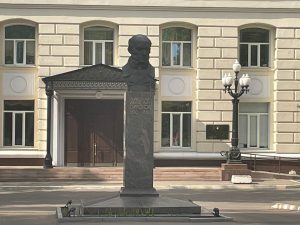Nikolai Ivanovich
Pirogov
1810-1881

Nikolai Ivanovich Pirogov was a Russian surgeon, anatomist, naturalist, and teacher. He was also a professor and the creator of the first atlas of topographic anatomy. Pirogov founded the Russian schools of military field surgery and anesthesia, and he was the thirteenth child in his family. According to some documents from the archives of the University of Dorpat, Pirogov’s birth may have occurred two years earlier, in 1808. He received his initial education at home and then attended a private boarding school in 1822-1824. Due to financial difficulties, his training was interrupted. Special influence on Pirogov’s choice of profession came from Professor of medicine E.O. Mukhin. Mukhin supported Pirogov financially and inspired him. Mukhin also offered Pirogov government-funded studentship, but his mother refused it, considering it unacceptable. In 1823, Nikolai, then only 14 years old, entered the Medical Faculty of Moscow University. He indicated in the documents that he was actually 16 years old to avoid financial difficulties that his family was facing. Nikolai did not have a student uniform and attended lectures in overcoats. His teachers were distinguished professors, including Loder, Mudrov, and Mukhin, who provided the foundation for his medical knowledge. After successfully completing the course in 1828, Pirogov became a physician and entered Professorial Institute at the University of Dorpat to train as a university teacher. There, he studied under Professor I.F. Moyer and became friends with Vladimir Dahl. He also met Vasily Zhukovsky and defended his doctoral dissertation in 1833 on the topic of ligation of the abdominal aorta for treating aneurysms. After that, Pirogov was sent to Berlin for further training, where he studied alongside other talented Russian students like Inozemtsev and Filomafitsky. Returning to his homeland in 1836, Nikolai Nikolayevich Pirogov hoped to take up the position of head of the Surgery Department at Moscow University. However, due to illness, he remained in Riga and the position was taken by another candidate. Instead, Pirogov accepted an offer from the University of Dorpat, becoming the first Russian professor of Surgery. In 1841, he was invited to St. Petersburg to head the Surgery Department at Imperial Medical and Surgical Academy, where he also established a surgical clinic at the Land Hospital for the Military. While training military doctors, Pirogov refined existing surgical techniques and developed new methods, including an operation that bears his name. He was the first to use frozen cadavers for anatomical research, leading to the development of topographic anatomy. His efforts for accuracy led him to publish the Latin Atlas in 1859, which became a valuable resource for surgeons. He was elected a corresponding member of the Academy of Sciences in 1846 and, just two years later, in 1848, he became a full member. He went to the Caucasus to serve in the army and there, he put into practice the use of starch bandages. These bandages proved to be more effective than previous methods and for the first time, he performed surgery under ether anesthesia in a field hospital. These achievements made him a symbol of progress in medical science and saved thousands of lives.
Address: Moscow, Nizhnyaya Pervomaiskaya str., 70, building 1

